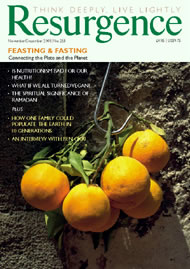I AM FROM the United States, founded on the impossible. Thomas Paine started the American Revolution, not to do the probable but to spite the impossible: true liberty and democracy. Nor were John Muir and Teddy Roosevelt being practical when they envisioned sea-to-sea national parks following centuries of extinction and deforestation. Had abolitionists practised the art of the possible in the racist mid-19th century, we might still have slavery. Sometimes the impossible is the only thing worth doing.
On the other hand, the very sentiment that founded the US also drives reckless pursuits, from genocide to nanotechnology. All kinds of idealism involve or even require exploitation, perpetual injustice or ecological disregard, and impossibilism may be the signature of wrongheaded fundamentalists everywhere.
For my money, one of its worst examples may be the one closest to our chequebooks – the fundamentalist belief in our 150-year-old economic experiment. As economist Herman Daly so heretically points out, the fatal flaw of free-market ideology is that sustainable growth is an oxymoron. Eventually growth runs up against sensitive ecosystems, and a finite Earth. Climate change is here to show us that economic activity can’t ignore limits and relationships forever – sometimes not even in the short term.
But impossibilism is infectious. Just about every player in the recent collapse of mortgage-backed securities, for example, was infected: homebuyers lusted for unaffordable property, mortgage brokers packaged their unpayable debts, investment bankers turned them into
riotous profits, right up to the Great Implosion. I paraphrase Jules Régis Debray, the French intellectual iconoclast, who might as well have been commenting on Bear Stearns in his 2003 warning about US ambitions in Iraq. “You lurch from one victory to another,” he wrote about the course of empires, “until your final collapse.”
With the financial collapse and resulting stagnation, perhaps there is a silver lining: the need to recognise limits. Earlier this year a San Francisco Chronicle piece called it “the Great Reckoning”– US consumers finally forced to live within their means because they can’t afford more. That only strengthens a heartening movement to eliminate excess here. Buy less. Drive less. Build green. Use clean energy. Even the conservative US Midwest has chimed in with RE-AMP, a well-funded regional coalition working to reduce fossil-fuel use in member states.
But like the growing spate of oil-company ads spinning their product as environmentally friendly, RE-AMP holds it as an article of faith that the US lifestyle must go unquestioned. The underlying message, if often unspoken, is this: we can still basically have it all. More local building materials, local food, renewable fuels by 2020: somehow we can sustain the lives that most US residents take for a birthright – lives obscenely privileged compared to the rest of the world and the balance of human history.
IS THIS JUST more impossibilism? Can benign alternatives to fossil fuels (which will eventually run out) really support our current lifestyles? Or must our rare privileges, so dependent on massive scale and complex exploitation of raw materials and people, inevitably disappear in the transition to local sustainable economies? If so, do the green fixes and forced reductions delude us? Or will they buy us enough time to reckon with the coming loss, prompting deeper change and adaptation to climatic chaos?
Like most of us, I can’t easily answer those questions because my loss still remains theoretical. To subsist, I interact with offices, bank machines, grocery shelves – they still buffer me from climate disruption, so far.
That luxury is not available to other North, South and Central Americans.
From the Amazonian fishers whose catch is already dying or leaving for cooler waters, to the Andean potato farmers already experiencing unpredictable rainfall and harvests, to the Inupiat settlements already bashed by coastal storms, their inland hunters hampered by unreliable ice, Indigenous communities here can no longer cling to the impossible.
“We can’t wait five years,” says Inupiat leader Patricia Cochran, Chair of the Inuit Circumpolar Council. “We’re a harbinger of what is to come, what the rest of the world can expect.”
Cochran, whose council is organising the Indigenous Peoples’ Global Summit on Climate Change in April 2009, points out that Arctic communities subsist directly with the land and water. “We see the subtlest changes because we are the most tied to them. We’re taught to see the connections. If you look at the centuries, we have been able to make it through extreme weather events and food shortages by understanding the world around us, using resources given to us, changing with resources as they change.”
This is a latent human ability – to live reciprocally with the environment. It can be learned. Perhaps global warming is a signal that it’s time for non-Indigenous cultures to begin the learning. “The more they see what’s happening in Indigenous communities, the more they see [their future] selves,” Cochran says. “The message is to understand the connectedness, and act now. I certainly hope that will happen. It’s a matter of individual responsibility – not only to other people but to themselves.”
I know: it may be hard to imagine that people will listen to the land and obey its messages, willingly giving up convenience and comfort. It sounds impossible. But so did Tom Paine’s version of impossible – and that’s the kind worth doing.







